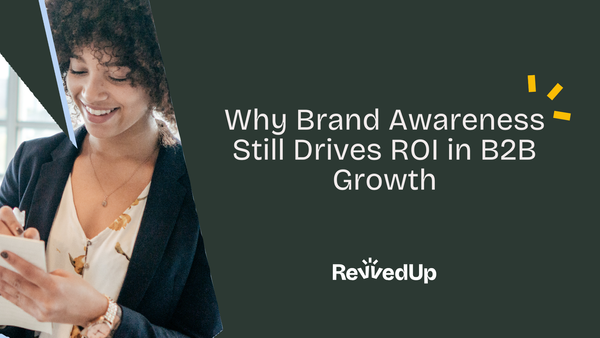Why Brand Awareness Still Drives ROI in B2B Growth

In the fast-moving world of B2B, buyers often choose the known brand over the objectively “best” solution. That’s not because your competitors have a stronger product - it’s because they’ve already earned trust and recognition in the market.
Yet brand awareness is often dismissed as a “soft metric.” Senior leaders push for pipeline, demos, and deals, while awareness programs are usually cut from budgets because they don’t show immediate returns.
Here’s the truth: brand awareness is one of the strongest ROI drivers in B2B marketing. It lowers customer acquisition costs, shortens sales cycles, increases win rates, and strengthens pricing power. In this post, we’ll break down why awareness matters, how to measure it, the tactics that work today, and how to tie it directly to ROI your CFO will love. Are you ready?
What is Brand Awareness in B2B?
Most people think of awareness as just being known. But in B2B, it goes much deeper.
- Recognition - prospects remember your company name when a need arises.
- Association - they connect your brand with authority, expertise, or outcomes.
- Trust - they believe your promises before you even pitch.
- Authority - they view your company as a credible voice in the industry.
- Positioning - they distinguish your brand from alternatives as the best match for a particular set of desired needs or outcomes
Unlike consumer marketing, where emotion drives much of the purchase, B2B involves multi-stakeholder committees, long cycles, and high-ticket investments. If your brand isn’t recognized and trusted, the evaluation process is slower, harder, and more expensive.
In short: awareness isn’t “just marketing.” It’s the foundation of demand creation and pipeline velocity.
Why Brand Awareness Translates Into ROI
1. Lower Customer Acquisition Cost (CAC)
According to HubSpot, companies with high brand awareness see up to a 33% lower CAC compared to lesser-known competitors. Why? Because familiar brands need fewer touches to convert.
Instead of spending thousands on ads, outbound calls, or long nurture campaigns, you’re already in the buyer’s consideration set. Awareness acts like an “unseen discount” on acquisition costs.
2. Shorter Sales Cycles
Gartner research shows that buyers spend 83% of their journey researching independently — before ever speaking to sales. If they’ve seen your brand in articles, LinkedIn posts, webinars, or industry events, that familiarity accelerates the trust curve.
By the time they book a demo, they already believe you’re credible. That can shave weeks or even months off complex B2B deals.
3. Higher Conversion Rates
Familiar brands win more deals. LinkedIn reports that buyers are 46% more likely to consider solutions from companies they recognize.
Awareness primes the buyer’s psychology. Even if they’re evaluating several vendors, they’ll lean toward the name they’ve already heard positive things about.
4. Pricing Power
Strong awareness creates a premium perception. Think Salesforce in CRM, HubSpot in inbound, or AWS in cloud computing. Buyers assume the market leader is more reliable, secure, and proven - even if a challenger has similar (or better) features.
This gives you pricing leverage. Instead of competing on discounts, you can hold margins while still closing deals.
How to Measure Brand Awareness
Many marketers fall into the trap of “vanity metrics” - impressions, likes, or followers. While those are directional, they don’t connect to ROI. Instead, here are measurable KPIs that matter:
- Branded Search Volume → Are more people Googling your company name?
- Direct Traffic → Are prospects typing in your URL directly?
- Share of Voice (SoV) → Are you being mentioned more than competitors in press, blogs, or social?
- Engagement vs. Reach → Not just who saw your content, but who engaged with it.
- Pipeline Attribution → Are opportunities showing awareness touchpoints in their journey?
💡 Example: A SaaS company tracked branded search volume and found a 40% increase in demo requests in the months following their awareness campaign. That’s not vanity — that’s pipeline impact.
Effective Tactics to Build Brand Awareness in B2B
1. Thought Leadership Content
Publishing insights on industry trends, customer pain points, and future opportunities positions your brand as the expert. Think:
- SEO-driven blog content
- LinkedIn leadership posts
- Webinars and podcasts
2. Category Education
The fastest-growing B2B brands don’t just sell - they teach the market. HubSpot taught inbound marketing. Gong taught revenue intelligence. If you can define the problem space, you control the narrative.
3. Strategic Partnerships
Industry associations, analyst firms, and events act as credibility multipliers. If you’re seen alongside established authorities, your brand gains weight by association.
4. Customer Advocacy & Social Proof
Logos, testimonials, and case studies prove your solution works in the real world. Peer-to-peer proof is one of the strongest awareness accelerators.
5. PR & Earned Media
Press coverage, award wins, and analyst mentions expand awareness beyond your owned channels. Being featured in a respected outlet gives you instant credibility.
Connecting Awareness Directly to ROI
Here’s a simplified framework to show the math:
ROI of Awareness Campaign = (Reduction in CAC + Increase in Win Rates + Pipeline Velocity Gains) ÷ Campaign Cost
👉 Example:
- Current CAC = $10,000
- Awareness campaign reduces touches by 25% → CAC = $7,500
- 50 deals/year → $125,000 savings
- Campaign cost = $40,000
- ROI = 3.1x
This is the kind of math executives and senior leaders love. It turns awareness from a “brand activity” into a financial lever.
Selling Brand Awareness to the C-Suite
Executives don’t buy impressions - they buy ROI. To win internal support:
- Frame Awareness as Cost Savings → Show how it lowers CAC.
- Show Revenue Impact → Link awareness to pipeline growth.
- Highlight Risk Reduction → Stronger brand = less churn, more stability.
- Report in CFO Language → Graphs showing ROI, not follower counts.
💡 Want a shortcut? Use our ROI Calculator to model how awareness impacts your acquisition costs and revenue potential.
Conclusion
Brand awareness is not a vanity metric. It’s the multiplier that makes every other part of your go-to-market engine more efficient.
It reduces costs. It accelerates sales. It increases win rates. It gives you pricing power. Most importantly, it proves that in crowded markets, the brand that’s seen first is often chosen first.
The companies that invest in brand awareness today are the ones that will dominate market share tomorrow.
👉 Curious what awareness could mean for your bottom line? Try our ROI Calculator and see for yourself.
